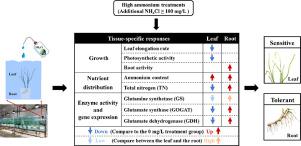Aquatic Toxicology ( IF 4.5 ) Pub Date : 2021-09-10 , DOI: 10.1016/j.aquatox.2021.105965 Hongrui Wang 1 , Xuexi Tang 1 , Jun Chen 1 , Shuai Shang 2 , Meiling Zhu 1 , Shuo Liang 1 , Yu Zang 3

|
Coastal eutrophication has resulted in the rapid loss and deterioration of seagrass beds worldwide. The high concentration of ammonium in eutrophic aquatic environments has been invoked as the main cause. In this study, leaves and roots of the seagrass Zostera marina were treated with simulated eutrophic seawater with elevated ammonium concentrations. The tolerance to ammonium stress and mechanism of nitrogen metabolism detoxification in different tissues were investigated. The results showed that high ammonium stress significantly affected the growth of leaves and had a negative effect on photosynthesis. The root activity of Z. marina was not inhibited at ammonium concentrations of ≤100 mg/L, indicating that the roots exhibited tolerance to ammonium stress. Increasing ammonium concentrations led to a higher increase of ammonium and free amino acid (FAA) contents in leaves than in roots. However, nitrogen storage decreased in Z. marina leaves after high ammonium treatments. The enzyme activity and gene expression of glutamine synthetase (GS) in roots were significantly higher than in the leaves even under ammonium stress. Meanwhile, ammonium stress increased the enzyme activities and gene expression of glutamate synthase (GOGAT) and glutamate dehydrogenase (GDH) in roots, which suggested that the roots had a strong ability to assimilate ammonium under ammonium stress. In contrast, although the GOGAT and GDH activity and gene expression in the leaves were initially increased, they significantly decreased when the ammonium concentration exceeded 100 mg/L. These results indicated that the concentration of 100 mg/L might be a threshold marking a transition from tolerance to toxicity for the leaves. Our study demonstrates that Z. marina leaves could be prone to higher damage than roots because the mechanism of ammonium assimilation in leaves is more susceptible to ammonium toxicity.
中文翻译:

Zostera marina 叶和根对铵胁迫的响应及对氮代谢影响的比较研究
沿海富营养化已导致全世界海草床的迅速丧失和恶化。富营养化水生环境中高浓度的铵被认为是主要原因。在这项研究中,海草Zostera marina 的叶子和根用铵浓度升高的模拟富营养化海水处理。研究了不同组织对铵胁迫的耐受性和氮代谢解毒机制。结果表明,高铵胁迫显着影响叶片的生长,对光合作用产生负面影响。Z. marina的根系活性在铵浓度≤100 mg/L 时不受抑制,表明根表现出对铵胁迫的耐受性。增加铵浓度导致叶中铵和游离氨基酸 (FAA) 含量的增加高于根。然而,Z. marina 的氮储存量减少了高铵处理后的叶子。即使在铵胁迫下,根中谷氨酰胺合成酶(GS)的酶活性和基因表达也显着高于叶片。同时,铵胁迫增加了根中谷氨酸合酶(GOGAT)和谷氨酸脱氢酶(GDH)的酶活性和基因表达,表明根在铵胁迫下具有较强的吸收铵的能力。相比之下,虽然叶片中GOGAT和GDH活性和基因表达最初增加,但当铵浓度超过100mg/L时它们显着下降。这些结果表明,100 mg/L 的浓度可能是一个阈值,标志着叶片从耐受性转变为毒性。我们的研究表明,Z. marina 叶子比根更容易受到损害,因为叶子中铵的同化机制更容易受到铵毒性的影响。



























 京公网安备 11010802027423号
京公网安备 11010802027423号